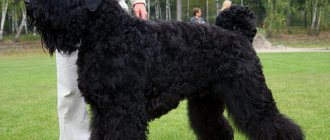The Smooth Fox Terrier is a versatile dog breed. Their small size, friendliness, loyalty and intelligence make them ideal pets.
But before purchasing a small hunter, it is worth familiarizing yourself with the description and characteristics of this breed, the features of care, feeding and training of these wonderful animals.
Origin story
The first written sources mentioning fox terriers date back to 1617. However, targeted selection for breeding the breed began only a century later. At this time, breeders planned to breed hunting dogs intended for burrow hunting. For this they received the nickname earthlings. The resulting breed primarily specialized in foxes, but could also hunt badgers and raccoon dogs. In the 18th century, the breed reached its peak of popularity in its homeland, England. Thanks to this, the breeders decided to continue the selection experiments, as a result of which the Wire Fox Terriers were born.
Smooth Fox: history of the breed
Fox terriers are a fairly “mature” breed by the standards of modern cynology - the first mentions of the predecessors of these miniature hunters date back to the 55th year of ancient years, even before our era. Small but formidable dogs hunting burrowing game were discovered and taken with them by the conquering warriors of the Roman Empire who landed on the British Isles. Wild dogs amazed the warriors with their unique ability - by chasing and catching prey in holes, the ancestors of foxes could remain underground for an amazing amount of time.
As a separate breed, Foxes have existed since the beginning of the eighteenth century - in ancient and expensive books on hunting, representatives of this ancient breed are depicted, as well as a description of the character and talents of Foxes. An English painting by the artist Sourri Gilpen, dated 1790, has also been preserved, which immortalizes a smooth-haired white and tan fox terrier nicknamed Pitch.
Painting of a fox terrier
Let us note that despite the external similarity of modern smooth-haired and wire-haired Foxes, as well as their belonging to the same breed, the ancestors of these dogs were different. To form the standard of the smooth fox terrier, wild hunting dogs from the islands of Britain were bred with beagles, greyhounds and even bull terriers; the ancestors of the wire-haired foxes were English terriers, and then the smooth fox terriers themselves. Thus, the latter became the progenitors of the “hard” Foxes.
Smooth Fox Terriers first appeared in Russia in the mid-18th century, when Prince Golitsin became interested in the charming English dogs with a strong hunting instinct. By 1860, the breed had spread quite widely and was recognized by Italian, Dutch and French dog handlers. Twenty years later, the breed was known in Norway, Australia, the USA and Germany.
Smooth Fox Terrier puppies
The English Kennel Club recognized the breed in 1875, and a year later the official fox terrier standard was established in the country's breeding club book. Later, the breed bearing the name “Fox Terrier” was recognized in America, and in 1993 the dogs were recognized by the International Federation of Cynology.
This is interesting! The most famous smooth foxsetter is a dog named Igloo, which belonged to Admiral Richard Byrd. The dog accompanied the owner on an expedition to the Antarctic, to the ice shelves, and is still considered the only animal that was in such an extreme situation.
The history of fox terriers goes back centuries
Description of the breed
It is characterized by a strong physique, despite its relatively small size. Representatives of this breed are distinguished by their speed, strength and endurance.
The build of the body is proportional, with a strong push off of the hind legs, they are strongly carried forward along the length of the entire body.
- The weight of a male can reach 7 kg -8.2 kg, but females weigh from 6.8 kg to 7.7 kg.
- The height at the withers of an adult male reaches 39.5 cm, females are slightly shorter.
- The limbs of dogs have well-developed bones.
- The hind legs are muscular, strong and straight.
- When examining the front paws, they should be straight, but set close and parallel to each other.
- The feet should form a continuation of the straight line of the shoulders.
- Hips are long.
- The chest of the breed is deep, while the ribs are moderately convex and elastic.
- The back is short, strong and straight.
- The coat of the Smooth Fox Terrier is straight, thick, harsh, smooth and close to the body.
- Color requires special attention - fox terriers are either pure white or white with brown or black spots. Any other markings are not acceptable.
- This breed has a scissor bite, the teeth are strong and strong.
The Smooth Fox Terrier breed is in excellent health, but may suffer from diseases such as diabetes, cataracts, epilepsy or deafness.
Smooth Fox Terrier: description and standard
For a long time, smooth-haired foxes were selected exclusively for practical purposes - burrowing, underground hunting. Therefore, the first representatives of the breed were powerful, had a rough build, had a large head with large jaws, and a short neck. In the 1900s, the breed “split” into two types: wire-haired and smooth-haired foxes. The latter were considered more classic, and many hunters preferred them, considering them “the elite of the breed.”
Later the standard also changed. Large, clumsy dogs began to be culled, choosing more graceful puppies for breeding. This is how fox terriers have survived to this day: graceful, elegant, but not “ringing”.
Modern Smooth Fox Terrier
An adult male fox terrier grows to 35-39 centimeters at the withers; the body weight of an adult dog reaches eight kilograms. Bitches are somewhat smaller - shorter, and their weight is about seven kilograms. In general, gender differences are small.
Foxes have a beautiful elongated muzzle, round, curious eyes set quite deep, and small triangular ears folded into an “envelope.” The fox terrier's ears are quite heavy, dense, well covered with hair, and go down to the cheeks due to their own weight. If this does not happen, the puppies' ears are glued, forming the correct outline of the head.
Correct ear position
The purebred Fox Terrier has a moderately narrow, flat forehead, tapering towards the line of the eyes, the transition from the muzzle to the forehead is weakly expressed. The nose mirror should be black, regardless of the color of the dog. Several colors are allowed: completely snow-white animals, as well as with red, black or black-red markings on white, with white wool always predominant.
These colors were not chosen by chance: it was extremely important for hunters that the dog’s coat contrasted with the shades of the game’s coat, so as not to accidentally hit the dog with a shot. In addition, the white dog, even soiled in the ground, was still visible, even in the twilight. It is for this reason that dark, and especially black fox terriers did not participate in breeding, and now do not exist.
Classic Fox colors
As befits burrowing hunting dogs, smooth fox terriers have short, straight and thick hair, which shortens towards the belly and groin, and somewhat lengthens on the back and hips. A dense coat allows the dog not to freeze in the water, and to feel free in the narrowest holes.
The entire structure of the dog’s body meets these same needs. Foxes have a dry, muscular and prominent neck, a deep but narrow and curved chest, and a flat back. The tail is set high and beautifully, it should neither be lowered down to the hind legs, nor curled in a handle or ring on the back. Previously, Foxes' tails were docked halfway to protect the dog from being bitten by wild animals. In this case, the tail stands vertically, like a stick. The dog's limbs are strong, compact, allowing the animal to dig the ground with force, as well as pursue even the fastest prey.
Standard Smooth Fox Terrier
Advantages
- The Fox Terrier is incredibly energetic. It is suitable for active people who love walks in the fresh air and active recreation.
- Fox will easily endure any trip accompanied by his owner. For families with children, this breed is a godsend. The dog will happily frolic with children of any age, and will also patiently tolerate and support the pranks of the youngest family members.
- The Fox Terrier is friendly, playful, hardy and easy-going. He is ready to tirelessly be the center of attention of the whole family around the clock.
- These dogs are quite good-natured towards strangers. But at the first sign of aggression, the pet will rush to defend itself or its owner.
Features of care
Some breeds require regular bathing, clipping and grooming to keep the animal clean and healthy. The Smooth Fox Terrier, on the other hand, does not take much time to groom.
All you need is just a bath when it gets dirty or after rolling out in the mud. The coat of dogs of this breed is smooth, tight-fitting, and sheds very little.
Advice! To protect your shins from scratches when your pet enthusiastically greets you, you need to keep his claws in order. To do this, periodically trim and file them with a special file.
Flaws
This breed is not suitable for homebodies or workaholics; in the absence of the owner, the pet will develop blues, and over time, signs of disobedience.
This is a dog that needs to be given quite a lot of time and attention.
It is possible to keep a Fox Terrier in the same territory with another dog, despite the jealousy inherent in the breed. But if there are cats, parrots and rodents in the house, buying such a dog is definitely not the best idea. The rest of the pets will be in constant danger of becoming prey, because Foxes have a very well developed natural hunting instinct.
This breed has a loud character and the pet often barks for various reasons. When kept in an apartment, this can lead to conflicts with neighbors.
Character
It is impossible to see a mini fox in a bad mood: he is always optimistic, courageous, persistent, and has innate hunting instincts. The animal's posture reveals its vigilance - it seems as if it is constantly in tension, ready to make a leap. He is smart, has a quick reaction, and makes decisions independently. Possessing a sanguine-choleric temperament, the terrier is ready to play sports and take part in games.
This small animal will get along with the same owner, who is always on the move. It’s not like on a walk - even at home the pet does not sit still. The Smooth Fox Terrier is perfect for families with children, no matter their age. He loves games, so he will take an active part in them. You can safely go on hikes, nature trips, or sports competitions with your pet. Terriers love to swim, overcome obstacles, dig sand and soil, and fetch objects.
The owner must respect and love the Fox - this is the only way to establish a trusting relationship with the dog. She needs to feel like a full member of the family and know about all events. Elderly, busy people should not get a terrier, since they cannot always separate its activity and mobility. The animal does not tolerate prolonged loneliness well, so it will cause chaos in the house if it is left without company for a long time.
He treats strangers evenly, without aggression, but in the right situation he will stand up for himself and his owner. Fox is a born hunter, whose genes immediately make themselves felt when a neighbor's cat appears. He will get along with small animals that have surrounded him since childhood and to which he is accustomed. By the way, fox terriers, who are trained from childhood and trained in professional hunting, are more serious and have high self-esteem.
Distinctive features
The FCI makes a clear distinction between smooth and wire fox terriers. However, the difference in the breed standard is essentially only in the description of the dogs' coat.
Thus, in wire-haired dogs, the most rigid, wiry-like coat is welcomed . The hair is dense, medium length. Slightly longer on the back and legs than on the whole body. A kind of beard is formed on the muzzle, which gives the muzzle an unusual expression and rectangular shape.
Smooth-haired cats have dense, short fur. The same throughout the body, only a little shorter on the muzzle and paws.
Otherwise the breed standard is similar:
- The body is strong and muscular, tends to square proportions (the length of the body is equal to its height);
- The body is narrow, seems light and taut like a spring;
- The head is flat, tapering towards the nose; the transition from the top of the head to the nose is almost invisible;
- Cheekbones are narrow;
- bite ;
- The jaws are strong with a full set of teeth;
- The eyes are round and dark;
- The ears are small, triangle-shaped; stand upright, but the tips are slightly lowered forward;
- The chest is narrow;
- The stomach is tucked;
- The legs are straight and strong with pronounced muscles;
- color - red and black spots on a white background; less common is two-color (according to the standard it is also acceptable, but not so loved by breeders) - white with red or brown spots;
- The tail is set as high as possible and looks upward; most often stopped; has rare strength (it can be used to pull and lift the dog if necessary). The Fox Terrier does not wag its tail like other breeds. He makes short movements, as if he is shaking.
The weight of dogs ranges from 6 to 8 kg , females weigh slightly less. The height of the dog at the withers is from 35 to 40 cm.
Breed characteristics
| Short description | |
| Origin: | England |
| Conditions of detention: | In an apartment, in a house |
| Purpose: | Companion dog, hunting dog |
| Color: | Tricolor (black and tan spots on a white background) |
| Wool length: | Short coat for smooth coats and medium wiry coat for wire coats |
| Adult dog size: | Height at withers – 35-40 cm, weight – up to 8 kg |
| Average life expectancy: | 12-15 years |
| Walk: | Daily long |
| Physical activity needs: | Average physical activity needs (walking 1 to 3 hours per day) |
| Fédération Cynologique Internationale (FIC) classification: | Group No. 3 terriers, section No. 1 large and medium terriers |
| Puppy price: | From 10,000 rubles - purebred pet-class puppies, from 20,000 rubles - show-class puppies, the price for babies from titled champion parents can reach 50 - 60 thousand rubles |
Characteristics of fox hunters
If we talk about temperament, the Fox Terrier is a lively, friendly dog, bold and very courageous. The Fox Terrier naturally has hunting instincts, he is energetic, hardy, easy-going and courageous. He has a very sensitive nose and increased activity; the dog cannot sit still for a minute.
Working tests for representatives of this breed are not mandatory, but the dogs must have anger towards the beast - this characteristic is considered fundamental. Outside the house, dogs are vigilant; they carefully examine everything around them, not missing details.
Such a pet equally needs regular physical activity and attention from the family. The dog endures prolonged loneliness very hard; it negatively affects both his mood and character.
A bored fox terrier turns into a pest, but he begins to bark for no reason, chew furniture and damage property not out of spite, but in order to show his owners how sad and lonely he is. That is why such a pet should be given to a family where someone is always at home.
The dog is very loving and friendly, it quickly gets used to its owner and household members, especially children. The dog is patient, playful and active, so it will be an excellent companion for a child in all mischief, pranks and games.
These little hunters do not have good relationships with other animals. Foxes, most often males, become fight starters, proving their superiority. And an animal running past, be it a cat or a mouse, inevitably becomes an object of hunting. Another nuance - the dog does not get along well with other animals for another reason - he is quite jealous.
It is not recommended for older or too busy people to have such a four-legged friend - the fox terrier needs training, active walks and frequent exercises on the playground. And if the owner is not going to go hunting, then you can involve the pet in sports - this dog is very successful in many disciplines
The pet is distrustful of strangers, vigilant, he is capable of being a fearless defender, so he can perform the work of a watchman. A loud bark will immediately notify all household members that a stranger has entered their territory.
Fox Terrier: psyche, character traits
The Smooth Fox Terrier is not one of the calm and phlegmatic breeds. These dogs have an extremely excitable nervous system; they are always ready to exchange a cozy bed for a walk or a hunting trip. This is one of the most active and energetic breeds; in addition, the strongest hunting instincts are manifested even in those dogs that have never seen game.
However, the Fox Terrier’s psyche is stable, they are well trained and fulfill the demands of a person, but only in a situation where they recognize him as a leader. Hierarchy is very important for the fox terrier - that is, from an early age the puppy must understand that a person is the leader and “the head of the pack.” Foxes need to be raised strictly, but sensitively and affectionately.
It is important for the Fox Terrier to understand its position in the pack.
The Smooth Fox Terrier has extraordinary intelligence, developed ingenuity, and is able to make decisions independently, without regard to the owner. The Fox's character is attentive, agility, fearless, and insatiable curiosity. This dog must always be in the center of events, and not the slightest detail will escape it. But, the qualities necessary for a hunting dog are not always desirable for a pet.
It's hard to imagine a dog worse than an ill-mannered Fox. If you do not pay due attention to the education, training and upbringing of the fox terrier, you can end up with an animal that will run away, always fight with other dogs, damage furniture and household things, bark loudly or howl from boredom.
By nature, Foxes are real hooligans
Table 1. Positive and negative character traits and behavior of fox terriers
| pros | Minuses |
|
|
Fox Terriers are constantly digging the ground
The owner of a Fox Terrier must be prepared for another breed feature - an almost uncontrollable desire to dig. This is characteristic of many burrowing breeds, such as dachshunds, jack russells , jagd terriers and others, including foxes. If the owner does not allow the animal to dig in the ground enough during walks, the dog will begin to dig the floor in the house, mercilessly spoiling carpets, laminate or linoleum.
However, a well-mannered fox terrier is the pride of the owner; he is a noble, fearless and very gentle friend who treats well not only the owner-leader, but also all other family members. Fox terriers get along well with children, but you should not leave them alone with very young children - their violent temperament can play a cruel joke on the fox, and he can knock over or accidentally injure a small child.
Foxes are wonderful playmates for outdoor games.
We should also talk about the relationships of fox terriers with other pets. As for other dogs, if the Fox did not grow up with them from puppyhood, then the problem may be constant dominance by the hunter. Fox Terriers have an impulsive, cocky disposition, they are not at all afraid of dogs that are larger than them, and at any moment they are not averse to finding out who is stronger.
Introducing pets correctly
If we talk about other pets - cats, domestic rabbits and other animals, then fox terriers can mistake them for prey. These dogs have a highly developed instinct of pursuit, so they are capable of attacking street cats, will not let a flock of pigeons pass by, and are capable of catching a field mouse or other animal. Therefore, you need to walk Foxes either on a leash, or in an equipped closed area, or in nature, away from other animals. You can let your dog off the leash only if it is perfectly trained and responds to the command “Come to me” in any circumstances.
For pets to be friends, they must grow up together from childhood
You need to understand that the fox terrier is driven by instinct to chase or search for game, so the dog completely forgets itself, not hearing the owner’s calls or other signals. Such escapes are fraught not only with the fact that the animal disappears from sight: the dog can get lost, get hit by a car, or be stolen.
Education and training
For the most part, fox terriers are not eager to learn, although it is quite possible to raise them into dutiful and obedient pets. The main thing is to demonstrate to the animal your own involvement in the process, and then the fox terrier himself will begin to bend over backwards to please his adored owner. It’s definitely not worth putting too much stress on a four-legged student: classes should be conducted in a lively, playful manner and not bore the dog with monotony. To do this, use the element of surprise more often. For example, change teams abruptly. By the way, experienced dog handlers recommend training after the animal has had a good run. In this case, it is easier for the puppy to concentrate on the instructions of the mentor.
It is very important to teach the Fox Terrier to curb its hunting instincts and emotions. During walks, the pet should behave more or less restrained and follow the owner’s commands upon request. Of course, from time to time the fox terrier will be “carried away” towards unwary cats, but such situations should be treated with understanding. A dog is not a robot, and from time to time it also needs to let off steam. One of the most important skills that a puppy needs to develop is using the outdoor toilet. And since fox terriers cope with this wisdom quite easily, then, if desired, they can be taught to relieve themselves on command.
The second useful skill that every fox terrier should acquire is normal leash perception. In parallel, learning to walk on a harness can be done with an OKD puppy, since wearing a collar in itself disciplines the pet, restraining its ardor, and therefore facilitates the training process. Considering the natural passion of Foxes for carrying objects in their teeth, they can be trained in fetching. At the same time, the toys that the animal brings should not be plastic or hollow, otherwise the fox terrier will quickly chew them.
Exhibition animals are taught to be touched from an early age. Fox terrier puppies are stroked on the back and head, pulled by the tail, gradually moving on to forming the correct stance. It is very advisable to involve strangers in this matter, since in the ring the dog will be mainly interested in strangers, whom it should perceive adequately.
At home, fox terriers also need to be taught standards of behavior and restraint. In particular, try not to treat your ward at the moment when you yourself are eating at the table, otherwise very soon he will begin to climb on it to enjoy it heartily (yes, Foxes are also unusually jumping). Be careful when choosing toys for your baby, because the Fox Terrier is a dog that loves to generalize everything. Therefore, if you tease your puppy with a rag or napkin, be prepared for the fact that he will see only another toy in the curtains and your trousers.
Training
You need to start training a Fox from puppyhood, so that in the future stubbornness and willfulness do not interfere with raising an obedient pet. The teacher must be fair and strict - these two qualities must be balanced. There should be no place for aggression, since the terrier will respond in kind. Training should begin at home, and commands should be given in the form of a game so that the baby moves a lot - this will be clearer for him.
The first command is getting used to the nickname. Then the puppy must learn where the toilet is, a place to rest, and get used to the collar, without which walking will be impossible. On the first walk, you need to teach the terrier to walk next to the owner, not to run ahead or to the side and not to trail behind. When the dog grows up, you can teach it to walk next to you without a leash. Then comes the turn of static commands: “sit”, “lie down”. The Smooth Fox Terrier must be praised for doing it correctly and treated to something delicious.
If the owner likes to ride a bike, you can train the puppy to run alongside while riding. It would be useful to teach how to overcome various obstacles. The main thing is that learning should arouse interest and enthusiasm, and not be boring. Foxes have a good memory, they quickly learn the material, but they do not want to consolidate it due to their willfulness and great activity. Undoubtedly, the owner must be persistent.
You can approve the correct execution of commands by reinforcing the praise with a treat at first. Then the dog will feel satisfaction, self-confidence, a taste of victory, and that will be enough.
How to care for a Smooth Fox Terrier?
Keeping a smooth fox terrier is not particularly difficult. The dog's short hair does not require any special care: it is enough to brush the dog once a week with a short-toothed massage brush or a rubber massage mitt. Fox terriers shed twice a year, and during these periods the dogs need to be thoroughly bathed with zoo shampoo and brushed more often so that the hair does not fly around the house.
There is also no need to wash your dog often. It is enough to bathe your pet once every three to four months, or after heavy pollution or swimming in natural bodies of water. Choosing a shampoo for a fox terrier is very simple - a moisturizer intended for everyday use will be quite sufficient. Before shows, the dog can be washed with a professional shampoo for white dogs.
Also, the Fox needs standard care, like any domestic dog. Once every couple of weeks, the animal’s claws are trimmed using a nail clipper (if the claws are worn down during walks, there is no need to further shorten them). The dog's teeth are brushed three times a week using dog toothpaste. For this procedure, you can purchase a special soft toothbrush, or you can use a bandage wrapped around your finger. It is necessary to accustom your puppy to brushing his teeth from a very early age in order to eliminate resistance in the future.
The owner of a Fox Terrier should regularly examine the ears and eyes of the pet in order to notice dirt or other problems in time. The rest of the list of care procedures and mandatory maintenance items looks like this:
- Annual vaccination (general vaccination against infections and viruses, as well as against rabies).
- Quarterly antiparasitic prophylaxis (deworming tablets).
- From spring to autumn – treatment for ticks, fleas and other insects.
If we talk about preparing for the arrival of a puppy in the house, you won’t have to spend much. The animal should have two bowls - for food and water, a strong collar, a leash for training (you can supplement it with a tape measure with a long cord for walking). The puppy will also need several toys (it is better to buy different ones: balls, tug-of-war ropes, a Frisbee disk, adapted for gnawing). If you don’t plan to let your dog sit on a sofa or chair, you need to buy or make a soft, spacious bed for it.
It is important that the dog receives enough physical activity, and when the pet is at home, communication with people. It is cruel to isolate a dog from family members; it is also unacceptable to keep a smooth fox terrier on the street, no matter whether in an enclosure or on a chain. These are social dogs that will suffer without human contact, which will have an extremely detrimental effect on both the Fox’s character and his health.
As for the health of the fox terrier, from the moment the puppy appears in the house, you need to find a good veterinary clinic where you can go for advice and treatment. It’s great if the dog has its own veterinarian who will be aware of its entire life history and illnesses.
Walk
Fox Terriers need long daily walks. Moreover, these should not be easy walks in the park, but an active pastime. Running, games, agility - all this is welcome.
Foxes are very playful, so a ball, frisbee or a simple stick will be great entertainment for them . It is also recommended to socialize them from a young age and take them out to playgrounds with other dogs. In puppyhood, fox terriers will easily get used to communicating with their own kind and will play with them with pleasure.
Residents of houses with adjacent territories are highly discouraged from simply letting their dogs out into the yard. They love to dig holes. The appearance of the lawn and any flower bed will be ruined if you leave your pet alone without supervision.
Grooming
There is no pronounced seasonal shedding in Foxes due to the lack of undercoat.
- However, smooth fox terriers require much less grooming - a simple brushing with a soft-bristled brush once a week is sufficient.
- Wire-haired dogs require a more careful approach - they need to be brushed with a stiff comb at least 2 times a week to avoid matting.
- Pets need to be trimmed several times a year to remove dead hair. If this is not done, various dermatological problems may appear.
Decorative haircuts are highly not recommended either for show dogs or for pets for the hobby. Any haircut can ruin not only the authentic appearance, but also the quality of the coat.
Bathing with shampoos should also be reduced to a minimum.
How to train a Fox Terrier: features
As you know, hunting breeds are the most temperamental, wayward and proud, so special attention should be paid to the education and training of the fox terrier. Firstly, there is no need to confuse these two concepts. Education is teaching the dog the basics of everyday life, so that the owner and his family feel comfortable in contact with the dog and sharing living space with it.
You need to raise a Fox from the first days of his arrival at home.
Upbringing
First of all, you need to determine the boundaries that the dog cannot cross. The animal must have its own place to sleep (or the dog will be allowed to nap in a chair or on the sofa) and to eat (it is unacceptable for the animal to take food to a secluded corner). The puppy must be provided with toys, explaining that chewing shoes or other objects is unacceptable. An important aspect is toilet training.
A puppy who already has all his vaccinations needs to be taken outside several times, taking treats with him. Every time the baby does his business outside the apartment or house, he needs to be vigorously praised and treated. A smart fox terrier will quickly understand what is required of him.
First walk
You also need to make it clear to your pet that you cannot make loud noises, for example, when greeting guests or jumping on people. At first, this is easy to do - the puppy should receive sufficient physical and mental stress for its age. A dog that has had a good walk, explored the surroundings, chased a ball or a bicycle, worked on obedience, and then eaten at home will sleep soundly and serenely.
Fox Terriers, in principle, are one of those breeds with which problems can only begin if the dog is idle. It is for this reason that, from the age of three to four months, a fox terrier must attend general obedience classes.
Training
The best option would be to attend group classes with a dog trainer. Since the Fox Terrier is not a guard or service dog, the best option would be to take a UGS (controllable city dog) or OKD (basics of canine training) course. Typically, the instructor selects a group of five to ten dogs of approximately the same age, who together learn the basics of training.
Active walks should alternate with training
Attending group classes is extremely beneficial. Not only the dog, but also the owner learns from them, this is especially important for those who have a dog for the first time. In addition, group classes form the puppy’s understanding of how to behave with other animals, teach him self-control, and reduce the excitement that often engulfs a fox terrier at the sight of another dog.
The result of training should be complete obedience of the animal. The dog must master basic commands: walking next to the owner (on a slack leash, without pulling), the ability to come on command, the “Sit-lie-stand” complex, giving an object (fetching). With each lesson, the program will become more complicated, its intensity and pace will change, so neither the owner nor the dog itself will get bored. You can attend such courses on a regular basis, since mental stress contributes to the dog’s pleasant fatigue no less than physical stress.
Fox Terriers easily learn even complex commands
Important point! The owner must understand that he should only visit the training area in a positive mood. All problems, as well as dissatisfaction with the dog, should be postponed until another time.
A dog will work only when it is praised and encouraged, when the owner shows with all his appearance that he is extremely happy with the pet’s success. If you treat the fox terrier rudely, shout at him or physically punish him, the animal will suffer even from the upcoming training and will stop trusting the person! Despite the fact that Foxes are hardworking and sociable, they are categorically intolerant of rudeness or pain. The dog will resist threefold if it senses violence.
Therefore, you need to work with fox terriers (and any other dogs) only with positive reinforcement. A competent instructor will definitely tell you how to reward your dog correctly. Each pet needs its own approach - puppies usually begin to be trained by motivating and rewarding with treats; later, food can be replaced with a toy, affection and verbal praise.
Video – Group training with a fox terrier
Canine disciplines
Smooth fox terriers, due to their energy and desire to interact with people, can participate in some canine disciplines, such as agility, coursing, Frisbee dog, freestyle. These activities will bring a lot of pleasure to both the dog and its owner, and will also allow you to develop your pet’s talents and tax his body and brain.
Table 2. Sports for the Fox Terrier
| Kind of sport | Description |
| Agility | A sport based on a dog passing an obstacle course. For a while, the pet must overcome the following equipment: barriers of various types and complexity, soft and hard tunnels, swings, slides, boom. The essence of the competition is that the animal cannot be forced - the dog enters the area without a collar and leash, and the owner can only encourage the dog with his voice. |
| Coursing | Run after a mechanical hare along a special track. Classes are held outside the city, in large cities in indoor halls with a special coating. The animal is muzzled and “game” is released in front of it, which the dog must chase. An ideal sport for hunting breeds, allowing them to release their energy and satisfy their instincts. |
| Frisbee dog | Chasing and catching a special rubber disc - frisbee. The owner must make a series of different throws, the dog's task is to catch the plate while it is in the air. Frisbee dog develops a dog from the physical side, as it is a set of running and jumping exercises, and also allows the animal to think logically and guess the trajectory of a flying object. |
| Freestyle | Dancing with a dog. A spectacular discipline that combines stunts and performing commands to music. The owner must choose certain music and put a number to it. Freestyle allows you to strengthen the relationship between the pet and the owner, and has a positive effect on trust and respect in the couple. In addition, the dog learns many complex tricks and non-trivial actions in a playful way. |
Fox terrier passes the "swing" projectile in agility
If the dog is going hunting, the owner must enroll in special courses, where the animal will be taught to approach the hole in response to a silent signal, look for and present objects, execute the “Look” command, and also behave calmly in a shoulder bag. They also work with the fox terrier in an artificial hole, teaching the animal how to navigate underground in the dark, pull prey out of the hole and bring it to the owner.
It is important to understand that until the dog has learned the basic commands, you cannot begin special training, much less take the dog hunting. An inexperienced pet can get lost or scare away game with a loud bark, or in the worst case, suffer in a fight with a wild animal.
Training area for hunting burrow dogs
Mating
To successfully breed a pet, you need to follow some rules:
- The age for breeding a fox terrier is no earlier than 18 months ;
- Females can be mated no more than once a year , so she will have time to restore her body;
- After reaching the age of seven, breeding dogs is strictly prohibited.
For assistance in the correct selection of a pair and the mating process, it is recommended to contact the nursery where the dog was purchased. Professional breeders will give valuable advice and warnings to the Fox Terrier owner, and will also help in finding a match for the dog.
Before mating, it is advisable for the couple to take a good walk together to allow the dogs to get used to each other and it is advisable not to feed both of them the day before.
It is better to conduct acquaintance in advance on neutral territory. The mating itself is done only on the male's territory . It is better to obtain more detailed information on mating, pregnancy and childbirth from experienced breeders who have been dealing with the breed for a long time.
Feeding the animal
Proper nutrition is the basis for a dog’s health, longevity and cheerfulness. An adult smooth-haired terrier is fed twice a day. The diet must necessarily include meat, fish and fiber, which is found in vegetables (carrots, pumpkin, zucchini, cabbage) and cereals (buckwheat, rice, oatmeal).
Your dog should not be fed sweets (which lead to diabetes and dental problems), spicy foods, pork, potatoes, beans and canned foods.
Breed diseases
With proper care, Fox Terriers live an average of 16 years. But representatives of this breed often develop hereditary diseases. More often they suffer from the following pathologies:
- hormonal disorders;
- allergic reactions, often food;
- dermatological diseases;
- Perthes disease;
- eye problems – distichiasis, cataracts, glaucoma;
- neurological disorders - dogs often suffer from epilepsy.
Health and life expectancy
On average, the lifespan of fox terriers ranges from 11 to 15 years. But if you create ideal conditions, it can increase by two to three years, or even more.
Infectious and cold diseases rarely visit fox terriers - thanks to the strong immunity inherited from their ancestors. But, unfortunately, there are genetic diseases. First of all this:
- cataract;
- diabetes;
- deafness;
- epilepsy.
Important! When buying a puppy, you should study the veterinary passport of the parents and find out whether the dog has a predisposition to such diseases.
Health
Fox Terriers are real long-livers . With proper care, they live more than 15 years. However, for such a result it is necessary to know the diseases to which the breed is predisposed, to be able to prevent them or to notice and treat them in time.
Vaccinations
Proper and timely vaccination is also the key to your pet’s health.
- For the first vaccination at 6-8 weeks, you need to treat the animal with all parasites (external and internal) in advance - 10-14 days before going to the doctor. At your appointment, your veterinarian will explain what medications are on the market and how they differ.
- Most often they recommend Biovac, Kanigen, Nobivak or Eurikan. The cost of the vaccine will depend on the chosen medicine (from 200 to 2,000 rubles).
- At 12 weeks a booster vaccination is required.
- Then the vaccine is given 6-7 months after the change of baby teeth to molars.
- At 12 months, another vaccination is given - against diseases (distemper, enteritis, parainfluenza and others) and against rabies.
Sometimes veterinarians advise vaccinating your pet against rabies at an earlier age. Only the owner decides whether to do this or not. After each vaccination, the dog will feel a little stressed and will be more lethargic than usual for a day or two.
Mixed breeds
Mixed breeds are dogs that do not have a specific breed. This is a “hybrid” - the result of crossing different breeds of animals. Such puppies show clear traits of their purebred parents, but officially they will be called “mixed breeds”. When purchasing a mixed breed, you are buying a “pig in a poke”, since no one can say for sure which qualities the puppy inherited from dad and which from mom. According to external signs, a guard dog may turn out to be an affectionate and cowardly guard.
Feeding regimen and diet
The owner can feed the pet with natural products or choose a suitable balanced food. When feeding naturally, you should create the most complete diet, which will include enough protein and other elements. But even in this case, it is recommended to give the dog vitamin supplements.
The dog should receive protein food, which is at least half of the total amount of food. Moreover, 2/3 is animal protein and 1/3 is plant protein. Sources of fiber are cereals - buckwheat, oatmeal, rice, and vegetables - carrots, pumpkin, cabbage. Porridges are seasoned with fresh herbs and vegetable oil.
It is advisable to give your adult pet a fasting day once a week. You can give your dog pieces of raw vegetables and rye crackers. For normal functioning of the digestive system, you should definitely give fermented milk products - cottage cheese, kefir, yogurt, etc.
When choosing dry food, you should pay attention to premium and super-premium brands - they contain high-quality ingredients and are better balanced. The Fox Terrier is suitable for a menu designed for dogs whose weight does not exceed 10 kg and leading an active lifestyle.
During any feeding, the pet must have round-the-clock access to clean drinking water, and it must be changed to fresh water daily. Adult dogs are fed twice a day, preferably in the morning and evening, puppies - about 4.
How to feed a Smooth Fox Terrier?
The most significant part of the life of any living creature, which greatly influences health and vital activity, is feeding. A balanced diet is extremely important for a dog, so the owner should approach this aspect with special care. First of all, you need to decide how the fox terrier will eat - dry ready-made industrial food, or natural products.
If the owner decides that the pet will eat dry food, you need to purchase a diet for dogs of medium breeds with high activity. You need to choose “super-premium” or “holistic” food, such as “Grandorf”, “Wolf’s Blood”, “Nau”, “Go”, “Akana” and the like. Considering that fox terriers are prone to allergic reactions, you should immediately purchase food from a hypoallergenic line to avoid unpleasant health surprises.
Holistic food
If natural feeding is chosen, then two-thirds of the dog’s diet will consist of fresh raw meat, sea fish, and offal. This type of nutrition is most typical for the stomach of a predator, and especially a hunting dog. Every day the fox terrier should receive fiber (vegetables and fruits: carrots, apples, zucchini, pumpkin), berries, fresh herbs, a small amount of cereals (rice, buckwheat).
Be sure to include lactic acid products in your diet: kefir, low-fat natural yogurt, yogurt. Natural feeding means that several times a week the animal will receive raw eggs, chicken or quail, and vegetable oils (raw fruits and vegetables are better absorbed with them).
Example of a single serving for a natural diet
If the animal eats natural products, it would not hurt to consult a veterinarian about vitamins or other elements that will need to be added to the diet additionally. The fact is that in ready-made industrial food all the substances necessary for a dog are already present, and in the required dosage, depending on the breed. Natural feeding is more difficult, and in order for the diet to be balanced, we recommend that your dog undergo a biochemical blood test every year, which will reveal deficiencies or surpluses of all important elements and substances.
Please note that there are also foods that cannot be given to a fox terrier in any form. The “black list” includes:
- Semi-finished products, smoked foods, fatty and salty foods, fried or deep-fried.
- Bones, no matter whether boiled or raw (hollow, tubular ones are especially dangerous).
- Game meat obtained by hunting (may be infected with intestinal parasites).
- River fish.
- Sweets, flour, baked goods.
- Grapes, nuts, plums and peaches, citrus fruits.
- Spices, herbs and any products in the preparation of which they are used.
In a special article , we will analyze in detail what you should not feed your dog, which foods are strictly prohibited for representatives of any breed, and can harm them.
Foods that seem tasty to humans are harmful to dogs.
How much does a Smooth Fox Terrier puppy cost?
When intending to purchase a Fox puppy, a person must understand that the purchase must be made only from breeders, in a nursery that deals with this breed. There is no need to fall for advertisements on social networks or on popular websites if sellers cannot confirm the pedigree of the puppies being offered, and also show the future owner all the documents, as well as the parents.
When purchasing a fox terrier, you also need to decide what class the puppy should be. If a dog is intended to please a person as a companion or go hunting with him, then puppies from a working pair (hunting dogs that have passed special tests) or the pet class should be considered. This means that the puppies were born from dogs with pedigree and show scores, but have some external defects. The cost of such a fox terrier varies between ten and fifteen thousand rubles, and this means that the dog will not be able to take part in exhibitions.
Breed-class puppies are dogs that meet the stated standard, but are unlikely to become ring stars and champions. As a rule, the breeding class includes females that are capable of bearing and giving birth to healthy offspring. Breeding bitches are usually mated with show dogs, who pass on their magnificent external characteristics to the puppies. Breed-class puppies can cost up to twenty thousand rubles, and “show” class fox terriers, the most promising for exhibitions, cost up to thirty thousand rubles and more, depending on their blood.
You must understand that the prices given above are approximate. So, for a puppy, a pair of working parents may well demand the same money as for a show puppy. But no matter what the dog is, the main thing is its character. Because a true fox terrier, despite external shortcomings, will always remain an active, brave and extremely loyal dog, ready to follow its owner anywhere.
NEAPOLITAN MASTIF: BREED STANDARD (APPEARANCE) AND GENERAL CHARACTERISTICS OF THE BREED
HUNGARIAN VIZSA: DISEASES AND CONTENT
Dachshund: HISTORY OF THE BREED, CHARACTER AND DISEASES OF THIS BREED OF DOG
COLLIE: HISTORY OF ORIGIN AND CHARACTER
What is the breed for?
Initially, these dogs, like many terriers, were used to hunt foxes, burrowing animals, rodents, badgers and Ussuri raccoons. They are excellent helpers for farmers, and thanks to their endurance and discretion, they are also excellent guards. Most often they are kept as pets and companions on various trips.
Choosing and caring for a puppy
It is better to purchase puppies from a breeder. When choosing a baby, you should pay attention to his behavior, temperament, habits, inquire about his pedigree, genetic diseases, and pay attention to the characteristics of his parents.
It is better to take an older puppy, 1.5-2 months old. At this age, the baby is already accustomed to eating food on his own and adapts faster.
Puppies before choosing
The best time to buy a puppy is the end of winter, the beginning of spring, when you can already walk outside under the gentle sun.
Feeding the dog
Smooth fox terriers do not belong to those breeds that suffer from frequent gastrointestinal diseases; they are unpretentious in food. But this does not mean that the dog can be fed with just anything. Decide what kind of food you will give: natural or ready-made. When feeding natural food, you should choose the right menu. The diet includes:
- lean meat, preferably raw (beef, chicken, rabbit, turkey, low-fat lamb);
- cereals (rice, oatmeal, buckwheat, less often barley);
- vegetables (carrots, sometimes boiled potatoes, cabbage);
- berries and fruits, except citrus fruits (occasionally);
- additional administration of vitamins.
Dogs should not be given pork, long bones, and wheat is undesirable. Smooth-haired terriers can be fed fish, but only sea fish, without small bones. If you buy ready-made food, choose high-quality food, starting from premium class. Look carefully at the composition; dry granules should contain meat, and not just animal protein. Undesirable ingredients include wheat, corn, cartilage meal and unknown by-products.











